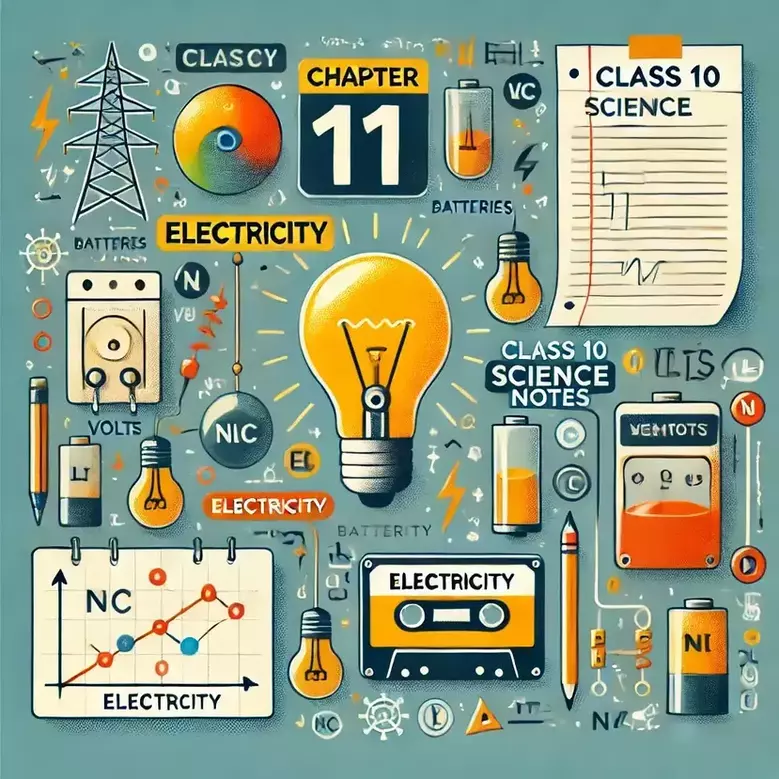Introduction
Electricity is a vital part of our daily lives, powering everything from lights to appliances. In this chapter, you will learn about the basic concepts of electricity, including electric current, voltage, resistance, and electric circuits. Understanding these fundamentals helps explain how electrical devices work and the principles behind their operation, preparing you for both exams and real-life applications. CBSE Class 10 Science Notes Electricity
Electric Current
The rate of flow of charge is called electric current.
Electric\;current=\frac{charge}{time}
i=\frac{q}{t}
Or q=it
- S.I unit is ampere (A).
- The electric current is measured by Ammeter.
Ammeter
An ammeter is a device used to measure the electric current flowing through a circuit.
- It is connected in series with the circuit component.
- Ammeter has a low resistance to ensure that it does not significantly affect the current flow.
Direction of electric current is taken as opposite to the flow of electrons. In a circuit electric current flows positive terminal to the negative terminal.
Charge
A fundamental property of a substance due to which it can feel force of attraction or repulsion when it comes in contacts with another charged particles called charge.
Electric charge (q) = ± ne
- S.I unit of charge is coulomb.
- Only two types of charges have been discovered.
- Positive Charge : A proton has a positive charge.
- Negative Charge : An electron has a negative.
- A neutron has no net electric charge.
- The proton carries a charge +e= 1.6× 10–¹⁹ C.
- The electron carries a charge -e = 1.6×10–¹⁹ C.
Electric Circuit
A closed path through which electricity can flow is called an electric circuit.
An electric circuit has a power source, wires, and components like resistors, bulbs, or switches. When the circuit is complete, the current flows from the power source through the components and back to the power source.
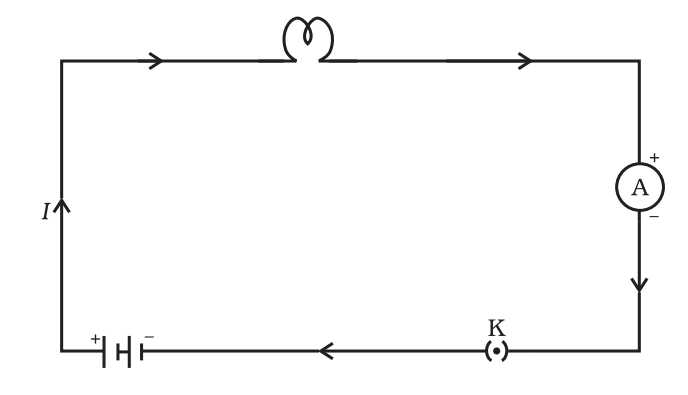
Example 1: A current of 0.5 A is drawn by a filament of an electric bulb for 10 minutes. Find the amount of electric charge that flows through the circuit. [NCERT]
Questions
1. What does an electric circuit mean?
2. Define the unit of current.
3. Calculate the number of electrons constituting one coulomb of charge.
Circuit Diagram
A representation of an electric circuit using standard symbols for various electric components is called circuit diagram.
Electric Potential
The work done in bringing a unit positive charge from infinity to a point inside the electric field is defined as electric potential at that point.
OR
Electric potential at any point is equal to the work done (W) on per unit positive charge (q) when unit positive charge is moved from infinity to that point.
Electric\;Potential(V)=\frac{Total\;work\;done(W)}{Total\;charge(q)}
- It is a scalar quantity.
- Its S.I unit is volt (V).
Electric Potential Difference (ΔV)
The amount of work done in bringing a unit positive change from one point to another in an electric field is called potential difference between the two points.
OR
The amount of work done to bring a unit charge from point A to B. This is called potential difference between A and B.
Electric Potential difference (ΔV) = VB – VA
- SI Unit Volts (V)
- The potential difference is measured by voltmeter.
1 Volt: When 1 joule work is done in carrying one coulomb charge then potential difference is called 1 volt.
Voltmeter
A voltmeter is a device used to measure the voltage between two points in an electric circuit.
- It has high resistance and always connected in parallel.
- Cell is the simplest device to maintain potential difference.
- Current always flow from higher potential to lower potential.
Example 2 : How much work is done in moving a charge of 2 C across two points having a potential difference 12 V? [NCERT]
Ans. 24 J
Questions
1. Name a device that helps to maintain a potential difference across a conductor.
2. What is meant by saying that the potential difference between two points is 1 V?
3. How much energy is given to each coulomb of charge passing through a 6 V battery?
Ohm’s Law
If physical conditions like temperature remain constant, the potential difference across ends of a conductor is directly proportional to the current flowing through it.
V = i R
Where: • V is the voltage (in volts). • I is the current (in amperes). • R is the resistance (in ohms).
Resistance
The hindrance to the flow of electric current is called resistance.
SI unit of resistance is ohm (Ω).
1 Ohm: 1 Ohm is the resistance of a conductor such that when a potential difference of 1 volt is applied to its ends, a current of 1 ampere flows through it.
Rheostat
A rheostat is a variable resistor that is used to control the flow of electric current in a electric circuit.
Rheostat can increase or decrease the current without interrupting the circuit. It is commonly used to dim lights, control motor speeds, or adjust the volume of audio devices.
Factors on which the Resistance of a Conductor depends
The resistance of the conductor depends (i) on its length, (ii) on its area of cross-section, and (iii) on the nature of its material.
Resistance depends on area of cross section: It is inversely proportional to the area of cross section (A).
R∝\frac{1}{A} ………(i)
Resistance depends on length of wire: It is directly proportional to the length of the wire (l).
R∝ l ……..(ii)
Combining the above equation,
we get, R∝\frac{l}{A}
R=ρ\frac{l}{A}where ρ(rho) is a constant of proportionality which is called the resistivity or specific resistance of the material.
Resistivity
Resistivity is a property of a material that measures how strongly it resists the flow of electric current.
SI unit of resistivity is ohm-meter (Ωm).
- Resistivity does not change with change in length or area of cross-section but it changes with change in temperature.
- Range of resistivity of metals and alloys is 10-8 to 10-6 Ωm.
- Range of resistivity of insulators is 10¹² to 10¹⁷ Ωm.
- Alloys do not oxidize (burn) readily at high temperature, so they are commonly used in electrical heating devices.
- Resistivity of alloy is generated higher heat than that of its constituent metals.
- Copper and Aluminium are used for electrical transmission lines as they have low resistivity.
Questions [ NCERT ]
Example 3 : (a) How much current will an electric bulb draw from a 220 V source,if the resistance of the bulb filament is 1200 Ω?
(b) How much current will an electric heater coil draw from a 220 V source, if the resistance of the heater coil is 100 Ω?
Ans: a) 0.18 A, b) 2.2 A
Example 4 : The potential difference between the terminals of an electric heater is 60 V when it draws a current of 4 A from the source. What current will the heater draw if the potential difference is increased to 120 V?
Ans: 8 A
Example 5 : Resistance of a metal wire of length 1 m is 26 Ω at 20°C. If the diameter of the wire is 0.3 mm, what will be the resistivity of the metal at that temperature? Using Table 11.2, predict the material of the wire.
Ans: 1.84 × 10–6 Ω (manganese).
Example 6 : A wire of given material having length l and area of cross-section Ahas a resistance of 4 Ω. What would be the resistance of another wire of the same material having length l/2 and area of cross-section 2 A ?
Ans: 1 Ω
Questions
1. On what factors does the resistance of a conductor depend?
2. Will current flow more easily through a thick wire or a thin wire of the same material, when connected to the same source? Why?
3. Let the resistance of an electrical component remains constant while the potential difference across the two ends of the component decreases to half of its former value. What change will occur in the current through it?
4. Why are coils of electric toasters and electric irons made of an alloy rather than a pure metal?
5. Use the data in Table 11.2 to answer the following –(a) Which among iron and mercury is a better conductor?(b) Which material is the best conductor?
Combination of Resistors
Series Combination
The combination of resistances in which two or more than two resistors are arranged one after another is called series combination.
OR
When two or more resistor are connected end to end then the arrangement is called series combination.
In this setup, the same current flows through each resistor, and the total resistance is calculated by adding up the individual resistances together.
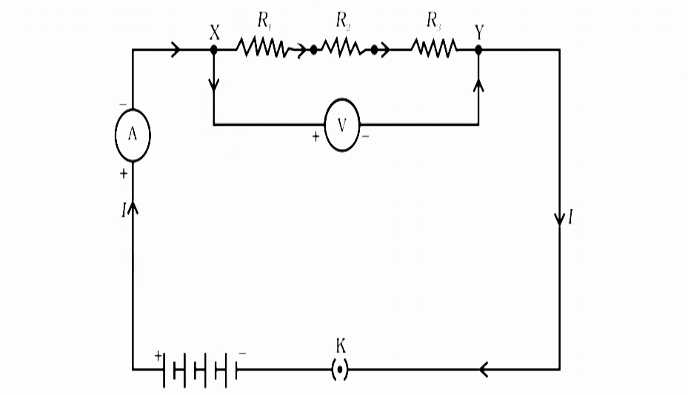
Total effective resistance in series
Rs = R1 + R2 + R3
For n Resistors
Rs = R1 + R2 + R3 +………Rn
Proof:
Total Voltage = Sum of voltage drop
V = V1 + V2 + V3
Voltage across each resistor
V1 = i R1
V2 = i R2
V3 = i R3
Then
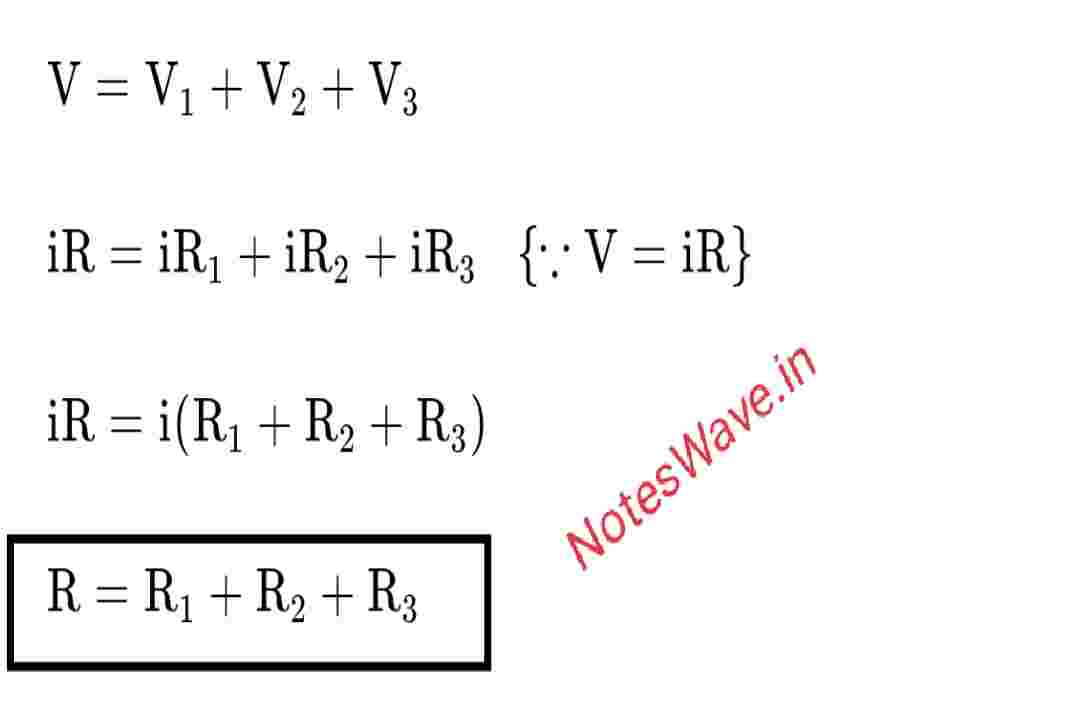
So we can say that, In series combination, the equivalent resistance is equal to the sum of all individual resistances.
Note: Equivalent resistance is larger than the largest individual resistance in the series combination.
Questions [ NCERT ]
Example 7 : An electric lamp, whose resistance is 20 Ω, and a conductor of 4 Ω resistance are connected to a 6 V battery (Fig. 11.9).
Calculate (a) the total resistance of the circuit, (b) the current through the circuit, and (c)the potential difference across the electric lamp and conductor.
Questions
1. Draw a schematic diagram of a circuit consisting of a battery of three cells of 2 V each, a 5 Ω resistor, an 8 Ω resistor, and a 12 Ω resistor, anda plug key, all connected in series.
2. Redraw the circuit of Question 1, putting in an ammeter to measure the current through the resistors and a voltmeter to measure the potential difference across the 12 Ω resistor. What would be the readings in the ammeter and the voltmeter?
Parallel Combination
The combination of resistors in which two or more resistances are connected between the same two points is called parallel combination.
In this setup, each resistor provides a separate path for the current to flow, and the voltage across each resistor is the same.
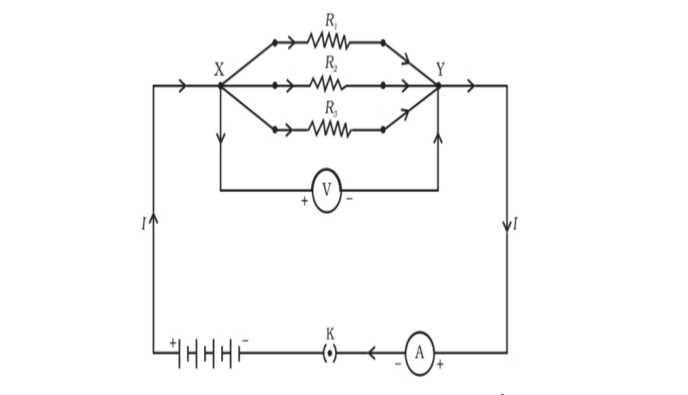
The total current is equal to the sum of current through the individual resistance.
i.e.
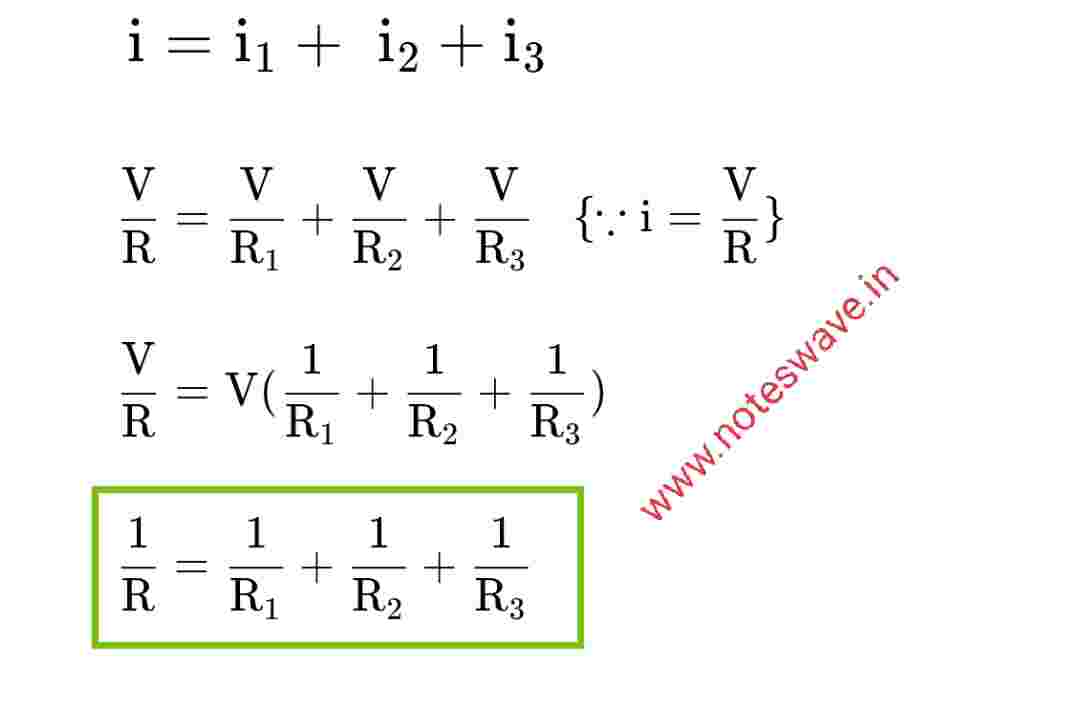
So we can say that, In parallel combination, the reciprocal of equivalent resistance is equal to the sum of reciprocals of resistances.
Note: Equivalent resistance is less than the value of the smallest individual resistance in the parallel combination.
Advantage of Parallel Combination over Series Combination
- In series circuit, when one component fails, the circuit is broken and none of the component works.
- Different appliances have different requirement of current. This cannot be satisfied in series as curent remain same.
- The total resistance in a parallel circuit is decreased.
Questions [ NCERT ]
Example 8 : In the circuit diagram given in Fig. 11.10, suppose the resistors R1,R2 and R3 have the values 5 Ω, 10 Ω, 30 Ω, respectively, which have been connected to a battery of 12 V. Calculate (a) the current through each resistor, (b) the total current in the circuit, and (c) the total circuit resistance.
Example 9 : If in Fig. 11.12, R1 = 10 Ω, R2 = 40 Ω, R3 = 30 Ω, R4 = 20 Ω, R5 = 60 Ω,and a 12 V battery is connected to the arrangement. Calculate(a) the total resistance in the circuit, and (b) the total current flowing in the circuit.
Questions
1. Judge the equivalent resistance when the following are connected in parallel – (a) 1 Ω and 106 Ω, (b) 1 Ω and 103 Ω, and 106 Ω.
2. An electric lamp of 100 Ω, a toaster of resistance 50 Ω, and a water filter of resistance 500 Ω are connected in parallel to a 220 V source.What is the resistance of an electric iron connected to the same source that takes as much current as all three appliances, and what is the current through it?
3. What are the advantages of connecting electrical devices in parallel with the battery instead of connecting them in series?
4. How can three resistors of resistances 2 Ω, 3 Ω, and 6 Ω be connected to give a total resistance of (a) 4 Ω, (b) 1 Ω?
5. What is (a) the highest, (b) the lowest total resistance that can be secured by combinations of four coils of resistance 4 Ω, 8 Ω, 12 Ω, 24 Ω?
Heating Effect of Electric Current
When an electric current passes through a conductor, the conductor offers resistance to the flow of electrons. As a result, some of the electrical energy is converted into heat energy. This process is known as the heating effect of electric current.
More heat is produced when the resistance is higher and the current is stronger. This effect is used in devices like electric heaters to create heat from electrical energy.
Joule’s Law of Heating Effect of Electric Current
Joule’s Law of Heating explains how electric current can produce heat. According to this law, the heat produced in a conductor when an electric current flows through it depends on three factors:
- The square of the current (I²) flowing through the conductor.
- The resistance (R) of the conductor.
- The time (t) for which the current flows.
The formula for Joule’s Law is:
H = i²Rt
Where:
- H is the heat produced,
- i is the current,
- 𝑅 is the resistance,
- 𝑡 is the time.
In simple words, more current or resistance will produce more heat over time.
Electric Fuse
It is a safety device that protects our electrical appliances is case of short circuit or overloadig.
- Fuse is made up of pure tin or alloy of copper and tin.
- Fuse is always connected in series with live wire.
- Fuse has low melting point.
- Current capacity of fuse is slightly higher than that of the appliance.
Questions [ NCERT ]
Example 10 : An electric iron consumes energy at a rate of 840 W when heating isat the maximum rate and 360 W when the heating is at the minimum.The voltage is 220 V. What are the current and the resistance in each case?
Example 11 : 100 J of heat is produced each second in a 4 Ω resistance. Find the potential difference across the resistor.
Questions
1. Why does the cord of an electric heater not glow while the heating element does?
2. Compute the heat generated while transferring 96000 coulomb of charge in one hour through a potential difference of 50 V.3. An electric iron of resistance 20 Ω takes a current of 5 A. Calculate theheat developed in 30 s.
Practical Application of Heating Effect of Electric Current
Electric Power
The rate at which electrical energy is consumed or dissipated in an electric circuit.
P= Vi
P= i² R
- The S.I unit of power is watt (W).
- Commercial unit of electrical energy is Kilo Watt Hour (kwh).
Questions [ NCERT ]
Example 12 : An electric bulb is connected to a 220 V generator. The current is0.50 A. What is the power of the bulb?
Example 13 : An electric refrigerator rated 400 W operates 8 hour/day. What is the cost of the energy to operate it for 30 days at Rs 3.00 per kW h?
Questions
1. What determines the rate at which energy is delivered by a current?
2. An electric motor takes 5 A from a 220 V line. Determine the power of the motor and the energy consumed in 2 h.
Class 10 Science All Chapter Notes
- Chemical Reactions And Equations
- Acid, Bases And Salt
- Metals And Non-Metal
- Carbon And Its Compounds
- Life Processes
- Control And Co-Ordination
- How Do Organisms Reproduce?
- Heredity And Evolution
- Light: Reflection And Refraction ✓
- The Human Eye & The Colourfull World
- Electricity
- Magnetic Effect Of Electric Current
- Our Environment
NCERT Books PDF Electricity
NCERT Solutions
- Class 10th Science Magnetic Effect of Electric Current
- Class 10th Science Electricity MCQ
- Class 12 Physics Practical File pdf Section A Experiment 6
- Class 12 Physics Practical File pdf Section A Experiment 2
- Class 12 Physics Practical File pdf Download Section A Experiment 1
